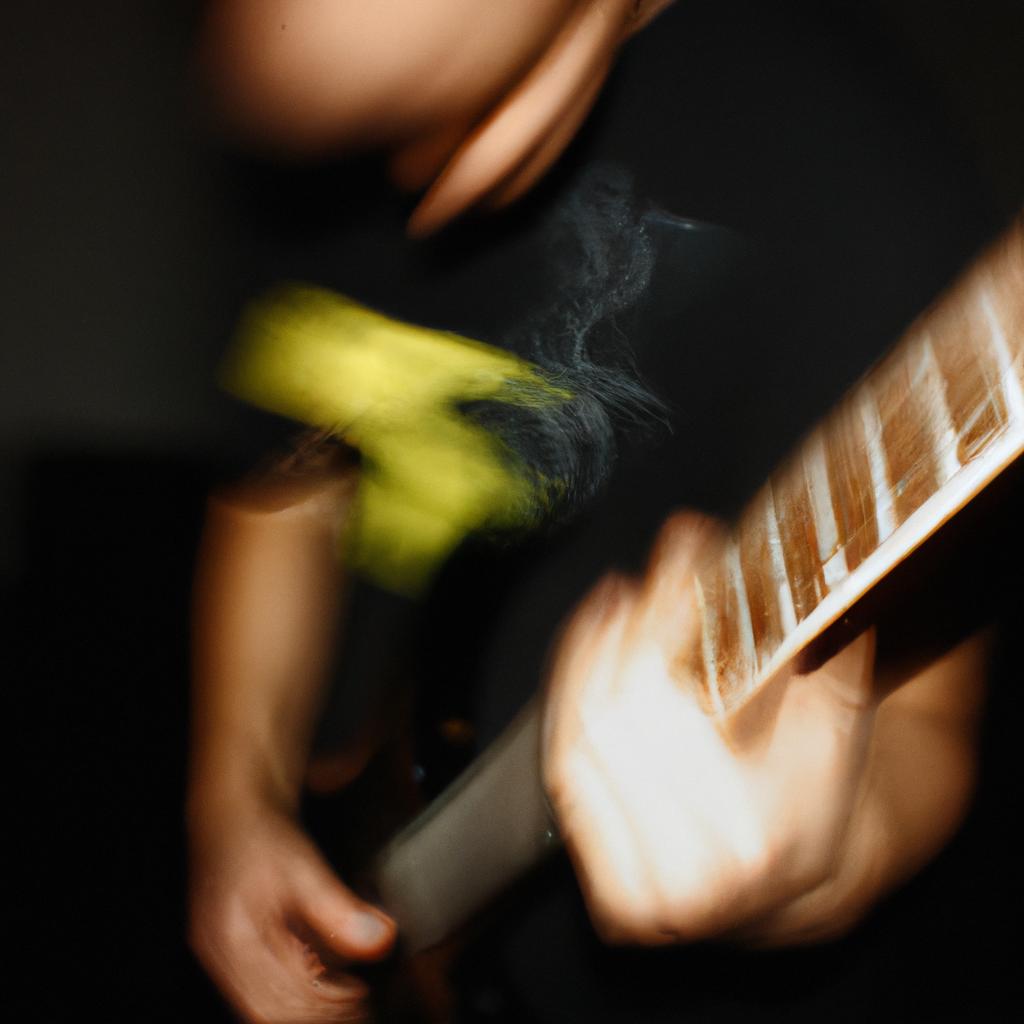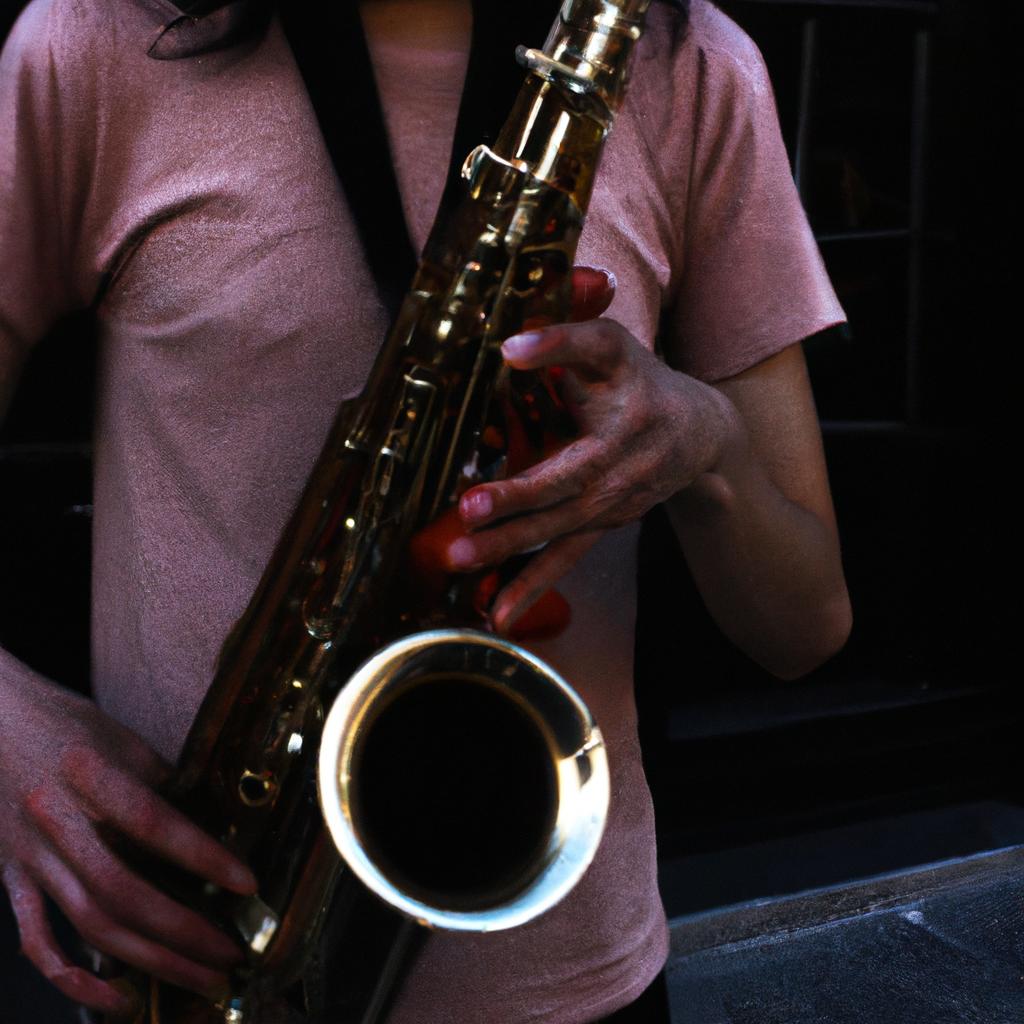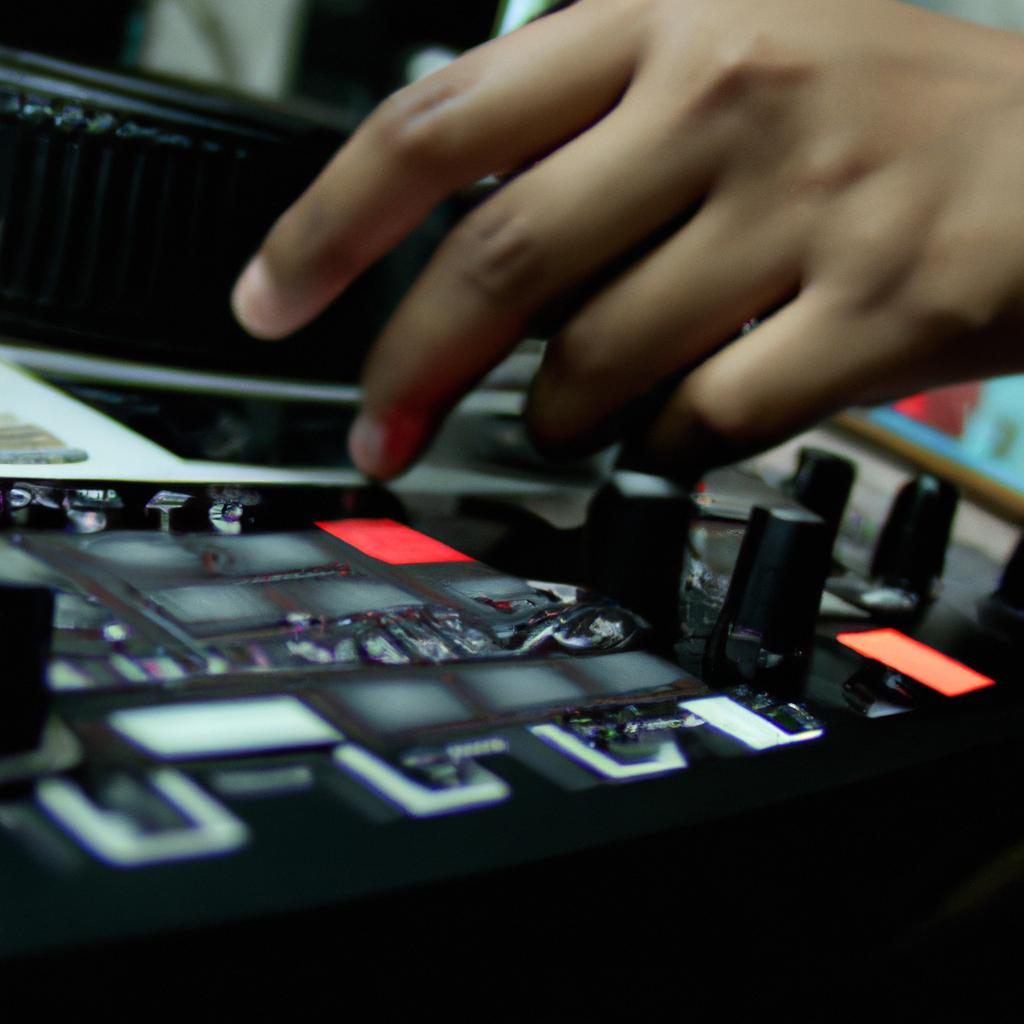The marriage of power electronics and gothic music has long been a subject of intrigue, sparking curiosity among both scholars and enthusiasts alike. This unique connection between two seemingly disparate genres embodies an intricate interplay of sound and aesthetics that warrants further exploration. To illustrate this point, let us consider the case study of renowned industrial band Nine Inch Nails. With their fusion of aggressive electronic beats and haunting melodies, they exemplify the symbiotic relationship between power electronics and gothic music.
Within the realm of power electronics lies a sonic landscape characterized by harsh, distorted sounds, often achieved through the manipulation of voltage-controlled devices. Its origins can be traced back to experimental artists such as Throbbing Gristle in the late 1970s, who toyed with unconventional instruments like modified tape recorders to create abrasive yet captivating audio experiences. In parallel, gothic music emerged as a subculture rooted in dark themes and introspective lyricism, drawing inspiration from literary works like Mary Shelley’s “Frankenstein” or Edgar Allan Poe’s macabre tales. The convergence of these two artistic expressions is evident in bands such as Nine Inch Nails, whose incorporation of eerie synthesizers and relentless drum machines resonates deeply with fans seeking a visceral musical experience steeped in atmosphere and emotional intensity.
One of the key elements that make the marriage of power electronics and gothic music so compelling is the shared emphasis on creating a sense of unease and introspection. Both genres often explore themes of existential dread, isolation, and inner turmoil, reflecting the darker aspects of human existence. This convergence allows for a seamless integration of aggressive electronic sounds and haunting melodies, resulting in a sonic experience that is simultaneously cathartic and unsettling.
Nine Inch Nails, led by frontman Trent Reznor, has been at the forefront of this fusion since their inception in the late 1980s. Their music combines blistering industrial beats with atmospheric synthesizers and Reznor’s emotionally charged vocals to create a sound that is both abrasive and deeply melodic. Songs like “Closer” or “Hurt” exemplify this dynamic by juxtaposing aggressive electronic rhythms with haunting melodies and introspective lyrics.
In addition to their musical style, Nine Inch Nails also incorporates visual aesthetics that draw heavily from gothic imagery. Their live performances often feature elaborate stage setups, lighting effects, and projections that enhance the dark atmosphere inherent in their music. This multimedia approach further blurs the lines between power electronics and gothic music, creating an immersive experience for fans.
The marriage of power electronics and gothic music continues to evolve and inspire artists across various genres. It serves as a testament to the transformative power of merging seemingly disparate artistic expressions into something new and captivating. Whether it be through bands like Nine Inch Nails or other innovative artists pushing boundaries, this unique connection will undoubtedly continue to intrigue scholars and enthusiasts alike for years to come.
The Origins of Power Electronics
Power electronics, a subfield of electrical engineering, emerged as a distinct discipline in the mid-20th century. Its development was driven by the need for efficient control and conversion of electric power across various applications, ranging from industrial processes to renewable energy systems. To illustrate this point, consider the case study of a manufacturing plant that relies on numerous high-power machines running simultaneously. Without proper control mechanisms, these machines may consume excessive amounts of electricity or suffer from voltage fluctuations, leading to reduced efficiency and potential damage.
One key aspect that sets power electronics apart is its ability to manipulate electrical power through the use of solid-state devices such as diodes, transistors, and thyristors. By employing these components in switching configurations, engineers can regulate voltage levels, convert between different forms of power (e.g., AC to DC), and efficiently manage energy flow within complex systems. This level of control not only improves overall performance but also enhances safety measures by mitigating risks associated with unstable power supply or sudden surges.
To further appreciate the significance of power electronics in modern society, let us explore some emotional responses it evokes:
- Empowerment: The advancement of power electronics has enabled individuals and communities to gain greater autonomy over their energy consumption. Through technologies like solar panels and battery storage systems, people can generate their own electricity and reduce dependence on traditional utility companies.
- Environmental consciousness: With growing concerns about climate change and rising carbon emissions, adopting more sustainable practices becomes imperative. Power electronics plays a vital role here by facilitating the integration of renewable energy sources into existing grids while minimizing waste during energy conversion.
- Economic benefits: Efficient utilization of electrical resources translates into cost savings for both individual consumers and large-scale industries. By optimizing power delivery mechanisms through advanced control algorithms and smart grid solutions, organizations can streamline their operations while reducing expenses related to electricity consumption.
- Technological innovation: Power electronics continues to drive innovation in various fields, from electric vehicles and aerospace systems to medical devices. The ability to efficiently manage power flow enables the development of new technologies that enhance our quality of life.
Table: Applications of Power Electronics
| Application | Description |
|---|---|
| Renewable energy | Power electronics plays a crucial role in converting and managing electricity generated by wind turbines, solar panels, and other renewable sources. |
| Electric vehicles | By controlling battery charging and discharging processes, power electronics ensures efficient use of energy in electric cars, buses, scooters, etc. |
| Industrial automation | In factories and manufacturing plants, power electronics helps regulate voltage levels and control motors for optimal performance while minimizing energy waste. |
| Medical equipment | Various medical devices rely on power electronics for precise control over electrical signals used in diagnostics, imaging techniques, surgeries, and patient monitoring. |
As we delve into the evolution of gothic music in the subsequent section, it is important to recognize how power electronics played an influential role in shaping this genre’s distinctive soundscapes.
The Evolution of Gothic Music
Power Electronics, with its roots in experimental music and industrial noise, has a distinct connection to Gothic Music. This section explores the evolution of Gothic Music and how it intersects with Power Electronics.
One fascinating example that illustrates the link between Power Electronics and Gothic Music is the collaboration between power electronics artist Prurient (aka Dominick Fernow) and British gothic rock band The Sisters of Mercy. In their joint project, they crafted a unique sound that merged elements of harsh noise with dark, atmospheric melodies. This fusion showcased the shared aesthetic sensibilities of both genres and highlighted their ability to create an immersive sonic experience.
The relationship between Power Electronics and Gothic Music can be observed through several key aspects:
-
Themes: Both genres often explore themes such as alienation, existential angst, decay, and darkness. These thematic similarities provide a common ground for artists from both backgrounds to collaborate or draw inspiration from each other’s work.
- Alienation
- Existential Angst
- Decay
- Darkness
-
Soundscapes: The use of electronic instruments, distorted vocals, heavy percussion, and unconventional production techniques are prevalent in both Power Electronics and Gothic Music. These sonically rich landscapes evoke intense emotions in listeners by immersing them in a world characterized by raw intensity and atmospheric gloom.
Power Electronics Gothic Music Instruments Synthesizers Guitars Distorted Vocals Atmospheric keyboards Percussion Synthesized strings -
Visual Aesthetics: Both genres share visual aesthetics that embrace darkness, morbidity, symbolism, and theatricality. Artists from both realms employ similar imagery such as religious iconography, occult symbols, macabre attire, and stage performances that blur boundaries between reality and fantasy.
The connection between Power Electronics and Gothic Music is a testament to the fluid nature of musical genres. As artists explore new sonic territories, they continuously draw inspiration from diverse sources. In the subsequent section on “Parallel Themes in Power Electronics and Gothic Music,” we will delve deeper into how these two genres share common thematic threads while maintaining their unique identities.
Parallel Themes in Power Electronics and Gothic Music
The Evolution of Gothic Music has paved the way for an intriguing connection with Power Electronics. This fusion can be observed through parallel themes and aesthetics that are shared by both genres. By exploring these similarities, we gain a deeper understanding of how Power Electronics and Gothic Music intertwine to create a unique artistic expression.
One example of this connection is evident in the use of dark atmospheres and haunting melodies. Both Power Electronics and Gothic Music often incorporate dissonant chords, eerie synth lines, and atmospheric soundscapes to evoke feelings of unease or melancholy. These sonic elements contribute to a sense of introspection and introspective exploration within the listener.
To further delve into the relationship between Power Electronics and Gothic Music, let us examine four key aspects:
- Aesthetic: The visual presentation in both genres often features imagery associated with darkness, decay, and industrial landscapes. This aesthetic choice creates a distinct atmosphere that resonates with listeners who appreciate the macabre.
- Lyrics: Themes such as existentialism, societal critique, isolation, and despair are prevalent in both genres. Through their lyrics, artists express emotions that resonate with individuals seeking alternative forms of self-expression.
- Performance Style: Both Power Electronics and Gothic Music utilize intense stage presence to captivate audiences. Whether it’s through aggressive vocals or theatrical performances, these styles aim to elicit strong emotional responses from spectators.
- Subculture: There exists a dedicated subculture surrounding both genres. Fans identify themselves not only through musical preferences but also by adopting specific fashion styles (e.g., goth fashion) and engaging in social activities like attending concerts or participating in online communities.
To visualize this connection further, consider the following table:
| Aspect | Power Electronics | Gothic Music |
|---|---|---|
| Aesthetic | Industrial | Dark romantic |
| Lyrics | Societal critique | Existentialism |
| Performance Style | Aggressive vocals | Theatrical presence |
| Subculture | Dedicated fanbase | Goth subculture |
This table highlights the overlapping aspects between Power Electronics and Gothic Music, further emphasizing their shared themes and aesthetics.
The relationship between these two genres is complex and multifaceted. As we explore the influence of Power Electronics on Gothic Music in subsequent sections, it becomes evident how this fusion has shaped both musical landscapes. By analyzing the various ways in which Power Electronics has influenced Gothic Music, we gain a deeper understanding of the evolution and interconnectedness within these artistic realms.
Influence of Power Electronics on Gothic Music
The parallel themes found in power electronics and gothic music are not merely coincidental, but rather arise from a shared desire to explore the darker aspects of human existence. One example that exemplifies this connection is the use of distorted soundscapes as a means of expressing anguish and despair. In both genres, artists manipulate electronic equipment to create harsh, abrasive sounds that evoke feelings of unease and discomfort.
To further illustrate this point, consider the following bullet points:
- Both power electronics and gothic music utilize dissonant chords and melodies to convey a sense of melancholy.
- Lyrics in these genres often delve into themes such as isolation, nihilism, and existential dread.
- Visual aesthetics play an important role in both power electronics performances and goth subculture, with dark clothing, makeup, and stage props creating an atmosphere of gloom.
- The incorporation of industrial imagery, such as machinery or factory settings, adds another layer of darkness to the overall aesthetic experience.
Additionally, we can observe the convergence between power electronics and gothic music through a comparative analysis using the following table:
| Power Electronics | Gothic Music |
|---|---|
| Heavy use of noise elements | Incorporation of atmospheric synthesizers |
| Emphasis on aggressive vocals | Utilization of ethereal female vocals |
| Sampling from various sources (e.g., news broadcasts) for lyrical content | Literary allusions and romanticized depictions of death |
In conclusion,
the parallels between power electronics and gothic music are undeniable. Through their shared exploration of dark emotions and thematic elements like distortion, dissonance, lyrics centered around desolation or despair, visual aesthetics evoking gloominess alongside industrial influences – it becomes apparent how deeply interconnected these two genres truly are.
Common Instruments and Techniques in Power Electronics and Gothic Music
Having explored the influence of power electronics on gothic music, it is now imperative to understand the common instruments and techniques employed in this unique genre. By examining these elements, we can gain a deeper appreciation for how power electronics intertwines with gothic music to create its distinct soundscapes.
To illustrate the interplay between power electronics and gothic music, let us consider a hypothetical scenario where an artist merges industrial noise with haunting melodies generated by vintage synthesizers. This intricate fusion showcases the creative potential that arises when both genres converge.
Instruments commonly used in power electronics include:
- Modular Synthesizers: These versatile instruments allow artists to generate a wide range of sounds using various modules such as oscillators, filters, envelopes, and sequencers.
- Drum Machines/Samplers: These electronic devices provide rhythmic foundations and enable musicians to incorporate unconventional percussive textures into their compositions.
- Field Recordings/Found Sounds: Artists often integrate field recordings or found sounds derived from everyday objects into their sonic palette, adding an element of realism amidst the synthetic layers.
- Effects Processors/Manipulators: Utilizing effects pedals or software plugins enables musicians to manipulate audio signals creatively, shaping them into distorted tones or eerie atmospheres.
Table – Emotional Response Evoking Elements:
| Element 1 | Element 2 | Element 3 | Element 4 |
|---|---|---|---|
| Raw | Intense | Haunting | Captivating |
| Brutal | Atmospheric | Disturbing | Enigmatic |
| Aggressive | Mysterious | Unsettling | Hypnotic |
| Chaotic | Ethereal | Melancholic | Transcendent |
Incorporating the emotional response evoking elements listed above, power electronics and gothic music converge to create an immersive experience for listeners. The raw intensity, haunting atmospheres, and captivating melodies combine with brutal distortions, unsettling ambiances, and enigmatic qualities to evoke a range of emotions that can be both powerful and mesmerizing.
Looking ahead, exploring future prospects in the connection between power electronics and gothic music promises further innovation within this niche genre. By pushing boundaries and experimenting with new technologies and techniques, musicians will continue to redefine sonic landscapes and captivate audiences with their unique amalgamation of industrial soundscapes and gothic aesthetics.
Transition into subsequent section about “Future Prospects of the Power Electronics and Gothic Music Connection”:
As we delve into the possibilities that lie ahead for power electronics in gothic music, it becomes evident that this union holds immense potential for shaping the future soundscape of these genres.
Future Prospects of the Power Electronics and Gothic Music Connection
Transitioning from the previous section that explored common instruments and techniques in power electronics and gothic music, we now delve into the profound influence that power electronics has had on the development and evolution of gothic music. One notable case study exemplifying this connection is the collaboration between renowned industrial musician Trent Reznor (Nine Inch Nails) and gothic rock band Bauhaus during their “Resurrection” tour in 2006. This unique partnership showcased how elements of power electronics seamlessly merged with traditional gothic soundscapes, creating a hauntingly captivating experience for audiences.
The integration of power electronics into gothic music opens up new possibilities for artists to explore dark atmospheres and intricate sonic textures. Through the use of various electronic devices such as synthesizers, samplers, and sequencers, musicians can create unconventional sounds that enhance the overall mood and intensity present in gothic compositions. Additionally, incorporating distortion effects, feedback loops, and noise manipulation techniques adds an element of rawness and grittiness to the music, amplifying its emotional impact.
- The blending of pulsating electronic beats with melancholic melodies creates a sense of contrast and tension.
- Industrial-inspired soundscape elements evoke feelings of alienation, darkness, and introspection.
- Distorted vocals combined with eerie atmospheric layers contribute to a sense of unease or foreboding.
- Experimentation with unconventional instrumentation enhances the overall aesthetic appeal by pushing boundaries within both genres.
Table: Comparison Between Traditional Gothic Music vs. Power Electronics Influenced Gothic Music
| Traditional Gothic Music | Power Electronics Influenced Gothic Music |
|---|---|
| Emphasis on guitar-driven melodies | Integration of electronic devices like synthesizers |
| Orchestral arrangements | Use of distortion effects, feedback loops, and noise manipulation |
| Lyrics often explore themes of love, loss, and mortality | Incorporation of industrial-inspired soundscape elements |
The power electronics and gothic music connection holds immense potential for future exploration. As technology continues to evolve, artists are presented with new tools and techniques to further push the boundaries of both genres. This innovative fusion not only adds depth and complexity to gothic compositions but also expands the sonic possibilities within power electronics itself. By embracing this synergy, musicians can create captivating auditory experiences that resonate deeply with listeners.
Through collaborations like Trent Reznor’s partnership with Bauhaus, we witness how power electronics seamlessly intertwines with traditional gothic music, enhancing its emotional impact and opening up uncharted territories in soundscapes. As more artists continue to delve into this intersection between genres, it is clear that the influence of power electronics on gothic music will persist as a driving force behind its evolution and development.




